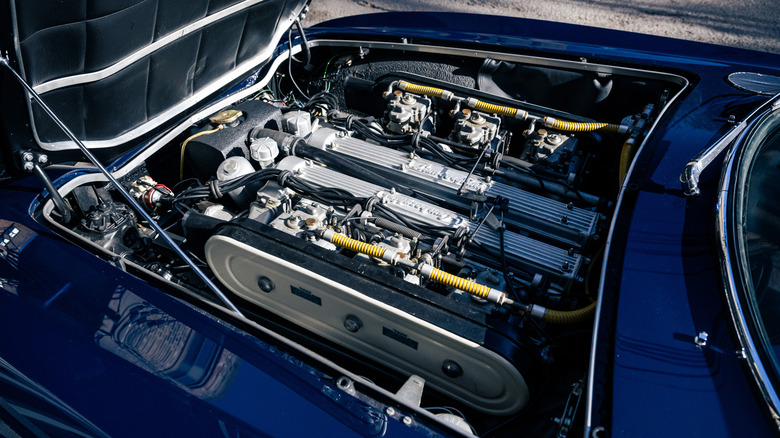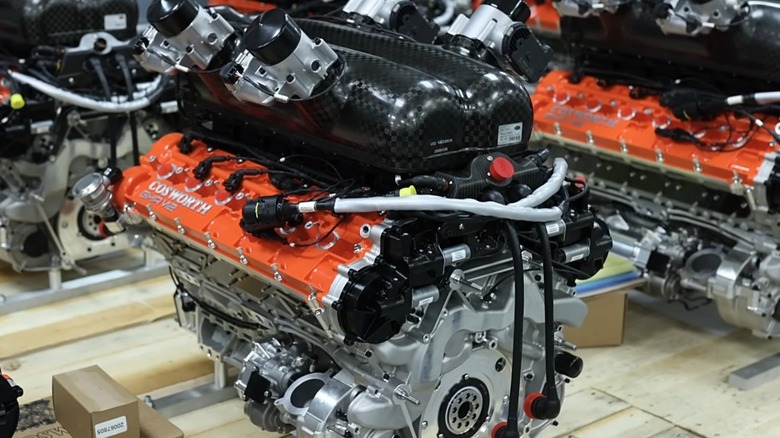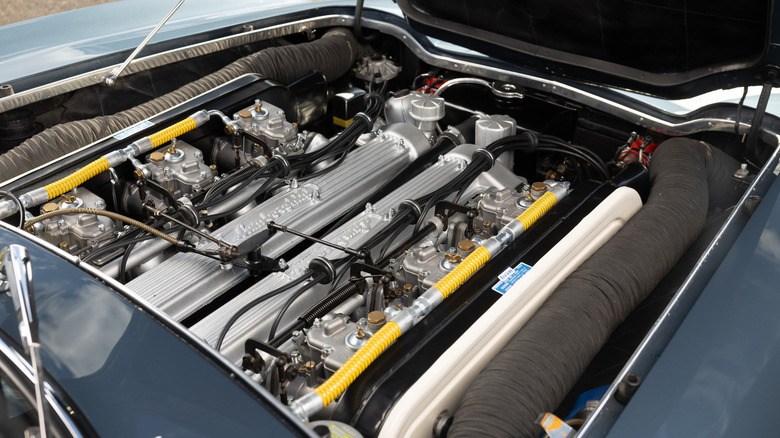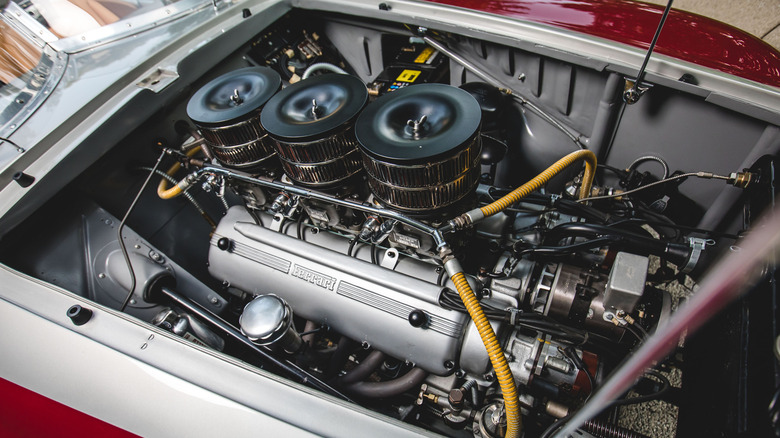5 Of The Smallest V12 Engines Ever Made
There is a range of common adjectives that come to mind when we think of V12 engines. "Smooth" is one, evidenced by engines like the V12 that powers the ultra-luxe Rolls-Royce Cullinan Series II. "Expensive" is probably another common adjective, since most modern V12-powered vehicles have eye-watering price tags. "Powerful" is also a given, what with cars like the Aston Martin Valkyrie and its headline-grabbing 1,000-hp V12. There are doubtless many more that have popped into mind as you read this, but one that likely hasn't is "small."
Most V12s are quite large engines, at least compared to the more mundane options we encounter daily. However, despite that, there have been a handful of V12 engines over the years that are genuinely quite compact. Some of these, like the Cosworth GMA engine, are only small by the standards of V12s, while others, such as Ferrari's immortal Colombo V12, are small no matter the cylinder count. And it's these engines we want to celebrate by journeying through the history of small V12 engines.
A quick note before we start, though: We're limiting this list to V12 engines that have powered road- or track-going cars, so we won't be discussing any mini V12 engine kits here. While they're fascinating products, we decided it would be unfair to pit vehicle engines up against these tiny marvels. But with that out of the way, let's get started.
3.9-liter Cosworth GMA
British automotive engineering company Cosworth has built many amazing engines since its founding in 1958, including classics like the Mercedes-Benz 190E's 2.3-16 engine and the race-proven DFV V8. But while those are all impressive powerplants, we'd venture that few are as special as the Cosworth GMA engine that it designed and built for Gordon Murray Automotive (GMA) and its vehicles, the T.33 and T.50.
GMA unveiled its first car, the T.50, in 2020, with press hailing it as the spiritual successor to the McLaren F1, which Murray also designed. The T.50's headline feature, beyond the fan-powered active aero, was — and continues to be — undoubtedly the engine, a naturally-aspirated 3.9-liter V12 that revs to an unprecedented 12,100 rpm and makes 660 hp. The T.50 was soon joined by the T.33 in 2022, which debuted with the same 3.9-liter Cosworth V12, albeit in retuned form. The T.33's GMA V12 had more low-rpm torque, with a lower redline — it maxes out at 11,100 rpm — and a slightly more daily-drivable 608 hp.
Cosworth and GMA also went another way with the V12, though, with an even more-powerful version featuring in the GMA T.50s. The T.50s is a special version of the T.50 that GMA first showcased in 2021 as a tribute to celebrate legendary F1 driver Niki Lauda, who passed away in 2019. Befitting Lauda's high-speed legacy, GMA equipped the T.50s with a redesigned version of the T.50's GMA V12 that made a staggering 761 hp.
3.5-liter Lamborghini Bizzarrini V12
Italian automakers are no strangers to small engines, not least thanks to post-oil crisis tax laws that pushed automakers like Ferrari and Lamborghini to create some of the smallest V8 engines ever. But Lamborghini had a history with surprisingly small engines even before the taxman pushed it to downsize in the '70s, as the Giotto Bizzarrini-designed 3.5-liter V12 from 1963 shows.
Lamborghini's relatively compact V12 powered the firm's first car, the GT 350, which debuted in 1964. The V12 made 320 hp, which was enough to push the luxury 2+1 grand tourer to an impressive-for-the-time top speed of 155 mph. Bizzarrini's V12 would go on to power many future Lamborghinis, including the 400 GT, Jarama, and the Lamborghini Miura, often hailed as the world's first supercar. Of course, the V12 didn't stay at its original 3.5 liters for long; the Miura's V12 had a 4.0-liter displacement, and later descendants would crank the power and size up even more. That's a story for another time, though.
An interesting note is that even though Bizzarrini's 3.5-liter V12 is plenty small for a 12-cylinder powerplant, it could actually have been even smaller. When Lamborghini roped Bizzarrini in to create its V12 engine, the designer already had plans for a 1.5-liter racing V12. However, the requirements of a grand tourer — and, perhaps, Ferruccio Lamborghini's desire to upstage Ferrari — eventually led to the 3.5-liter V12 that debuted in the GT 350. If you want to see it yourself, good luck — one sold in a Sotheby's auction last year for $630,000.
3.3-liter Ferrari Lampredi V12
Any automaker is most associated with the small V12 amongst motorheads, it's probably Ferrari, which featured two great sub-3.5-liter V12s in its cars over the years. The larger of the two is also the newer one, although it's by no means a recent engine: Say hello to the Lampredi V12, in production from 1950 to 1964.
Designed by Aurelio Lampredi, Ferrari's '50s V12 was built on the foundations of the firm's first — and smaller — Colombo V12, which we'll discuss later. The master plan was for Ferrari to take the fight to contemporary rivals such as the French Talbot-Lago team, which had seized victory at the 1950 24 hours of Le Mans. Talbot-Lago cars had 4.5-liter engines, and that's what Lampredi's V12 was designed for. However, the V12 debuted with a 3.3-liter displacement in the 275 S from 1950.
The 3.3-liter V12 in the 275 S featured three Weber carburetors and made an impressive 266 hp (199 kW), which was good enough to take the open-top racer to a heady top speed of 149 mph. By 1951, Lampredi's V12 reached its 4.5-liter target in the 375 F1, with its 350 hp helping Ferrari achieve its first-ever F1 win at the British GP. The final flourish for Aurelio Lampredi's work came in 1964, when a 400-hp, 5.0-liter V12 that combined his and predecessor Gioachino Colombo's work powered the Ferrari 500 Superfast. Finding examples of Lampredi's work to try is tough these days — a 1951 Ferarri 340 sporting a 4.1-liter model sold just this year through a Sotheby's auction for over $3 million.
3.0-liter Matra V12
French automaker Matra may not be a household name, but it has a storied history, producing a range of quirky sports cars in the 1960s and '70s. It had some racing success, too, earning three consecutive Le Mans wins in the early 1970s. These wins, earned in collaboration with French firm Simca, owed much to Matra's in-house engine, a 3.0-liter V12 that produced 450 hp and 299 lb-ft of torque. This wasn't Matra's first V12, though.
The brand had been involved in racing since the mid-1960s with Formula Two racers like the MS5. These early efforts had third-party engines from the likes of Ford, and it wasn't until 1967 that the French automaker began working on an in-house engine. A deal with Elf Oil allowed Matra to design and build a 3.0-liter V12 for Formula One; the MS9, as it was known, debuted in 1969. It was a 400-hp screamer with six dedicated exhaust pipes and it powered the Matra MS11 racer in a handful of races during the 1968 F1 season, albeit without much success.
The V12's F1 stint was short-lived, with Matra's MS80 from 1969 switching to a Cosworth engine. The MS80 won the constructors' championship and handed F1 legend Jackie Stewart his first drivers' championship, but Matra didn't abandon the V12 entirely despite this success. An updated V12, dubbed the MS12, returned for the 1970 F1 season, and further developments eventually led to the MS73 V12 that gave Matra-Simca its back-to-back Le Mans wins in 1972, 1973, and 1974.
1.5-liter Ferrari Colombo V12
Few V12 engines are as celebrated as this one. Ferrari's Colombo V12 is hailed as an exceptional example of the art of the V12 and regularly features on lists of the best V12 engines ever made. It's Ferrari's first-ever V12, and it's also remembered for being exceedingly small, at least in its initial form.
Named after its designer, former Alfa Romeo employee Gioachino Colombo, the Colombo V12 displaced a positively tiny 1.5 liters — which, for context, is the same as the 2025 Honda Civic Si. Ferrari head honcho Enzo Ferrari wanted a 1.5-liter engine, and Colombo was up for the task of squeezing 12 cylinders into such a small form factor. The result was an over-square V12 that powered the 1947 Ferrari 125 S, making 118 hp. While that may seem mundane now, the engine helped Ferrari's debut car win six out of the 13 races it competed in that year, so it certainly was no slouch.
Like many other small V12s, Colombo's baby would get bigger as the years went on. 1948 saw the V12 hit 2.0 liters in cars like the 166 Inter and 166 MM — one of which sold at auction for over $3.8 million a few years ago — producing 140 hp in the latter. Colombo returned to Alfa Romeo in 1951, eventually designing a championship-winning 1.5-liter straight-eight engine. While Colombo's stint with Ferrari was brief, the engine he designed would last until the 1985 Ferarri 412, which boasted a 340-hp, 5.0-liter version of the venerable 12-cylinder.





